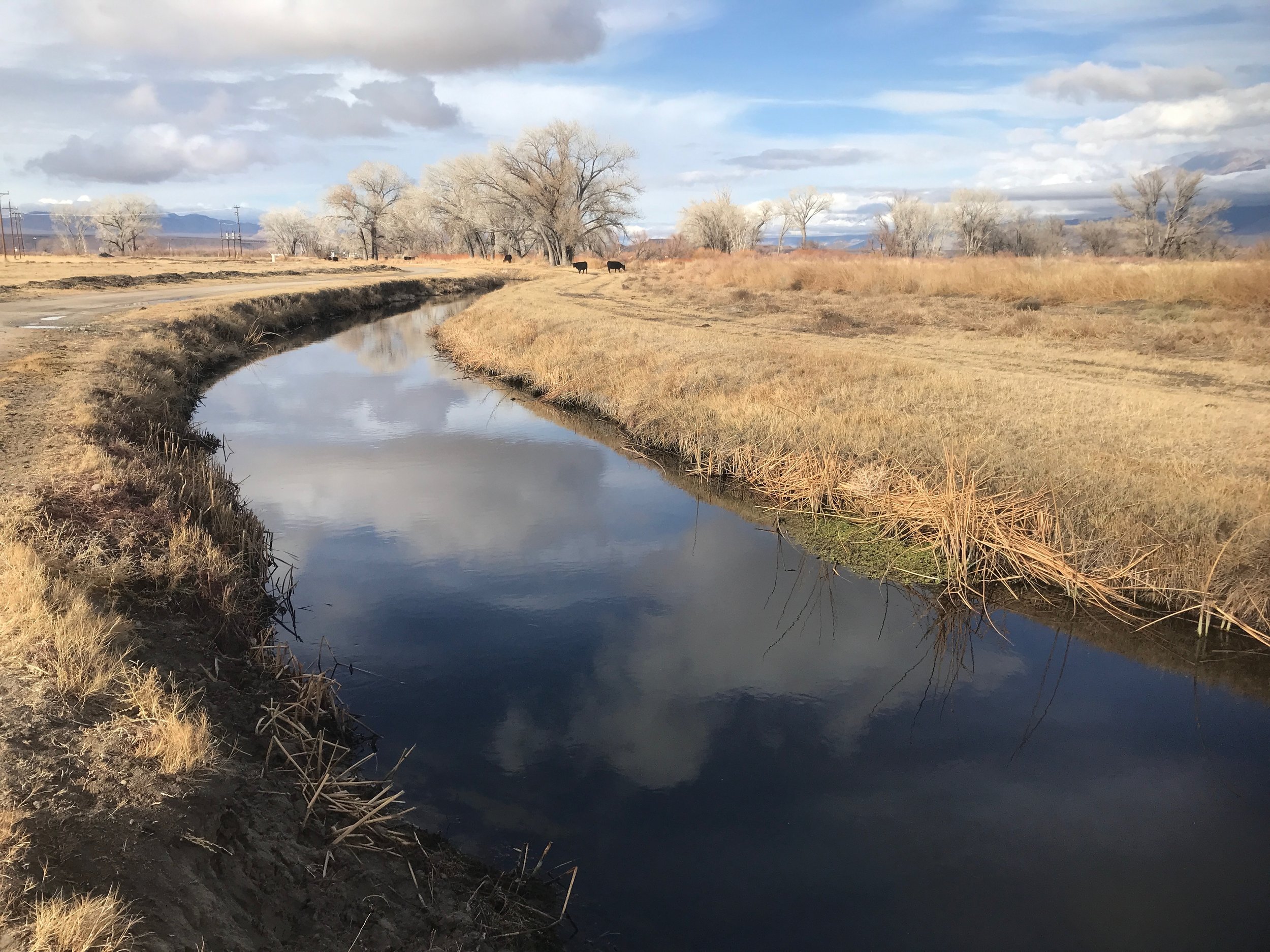When I was a surfer and there was a big swell hitting the coast every surfer came out of the wood work to enjoy the swell. Will it seems the fly fishers are coming out of the wood work to enjoy the fly fishing opportunities that are available right now in the Eastern Sierra. Nymphing with mayfly nymphs, stonefly nymphs, black fly larvae and midges is producing trophy trout and wild trout as small as four inches. While there are not a lot of trout feeding on the surface there is some dry fly activity to be found on Eastern Sierra waters. I will be at the Bart Hall Show in Long Beach from Thursday January 25th through Sunday January 29, 2024. I will have a limited number of flies for sale. I will be presenting Bishop: The Southern Gate Way to Eastern Sierra Fly Fishing, Nymphing: The art of Fishing Flies on the Substrate and Tuesday Talks With Fred a panel discussion with Richard Lancaster, Tom Paulson and Fred Rowe.
Lower Owens River
Wild Trout Section:
Fly fishers are aware that the flows are down to 150 CFS and the trout are feeding on nymphs. Fly fishing pressure is gaining momentum. Every day I’m on the water I’m patterning where I’m catching trout and what fly patterns are producing. I’m working the riffles with little to no results. Pools and runs are what are producing. Stomach pump samples show that the trout are feeding on stone fly nymphs, hydropsyche caddis, stick caddis, mayfly nymphs and black fly larvae. Stoner nymphs, olive burlap caddis, bead head flash back pheasant tail nymphs, peeking caddis, olive WD40’s, Frenchie’s, olive quilldigons, Duracell nymphs, tiger midges, cream midges and zebra midges are imitating the insects that the trout are feeding on.
Accessing the hard to reach spots that are inundated with tulles and willows is easier when the flows are at 150 CFS and fly fishers can safely wade the river.
Hot Creek
Interpretive Site:
Fly fishers are driving right up to the Kiosk and walking out to the creek to fly fish. If your there on the right day you will be able to throw dry flies for surface feeding trout. Most days nymphs are doing the job of producing the trout. Olive scuds, bead head flash back pheasant tail nymphs, olive quilldigons, brown or olive WD40’s, Frenchie’s, tiger midges, zebra midges, blood midges, soft hackle brassies and two tone brassies are fooling the trout feeding on nymphs. Blue wing olive parachutes and Griffith’s gnats are the flies I keep in my fly box for when the trout come to the surface to feed.
Euro nymphing is a very successful method of nymphing Hot Creek Canyon.
Hot Creek
Canyon Section:
Fly fishers are having no problems with snow or ice as the warm weather this week made quick work of the little snow that was on the ground. I like fly fishing in the canyon. It’s were I honed my fly fishing skills for selectively feeding trout. By early afternoon the canyon is engulfed in shadows and is too cold to be fly fishing in the winter time. I like to thoroughly cover the water and then move about ten feet upstream and repeat the process. Winter feeding trout will not move very far for the nymph pattern so be sure to put the fly right on the trout’s nose. Choose size 18 to 22 tiger midges, blood midges, zebra midges, brassies, soft hackle brassies, bead head flash back pheasant tail nymphs, olive quilldigons, Frenchie’s and hot spot pheasant tail nymphs to fool the wary wild trout of Hot Creek.
Anatoliy Antonov from San Francisco with a trophy rainbow trout that he caught while nymphing one of the deep holes on the upper Owens River.
Upper Owens River
Above Benton Crossing Bridge:
At this time last year fly fishers were snowmobiling, cross country skiing or walking into the upper Owens River to pursue the trophy rainbow trout that migrate up out of Crowley Lake to spawn in the gravel beds. This year fly fishers are driving right up to the river to fly fish just like they do in the summer time. The trophy trout fly fishing is peaking and fly fishers diligently working size 12 stoner nymphs, green/gold Prince nymphs and gold ribbed hare’s ears in deep holes, deep runs and cutbanks on the substrate are catching the trophy trout. A lot of fly fishers are catching the trophy trout with bright red, pink or orange egg patterns, San Juan worms and squirmy wormies. There has been consistent action from juvenile trout from 6 to 10 inches feeding on midges and mayflies. A size 16 or 18 Adams parachute with a size 16 gold ribbed hare’s ear or size 18 bead head flash back pheasant tail nymph dropped three feet below the dry fly is fooling these juvenile trout.
Bishop Creek Canal flows are at their lowest levels and it’s hard to cast to the fish without spooking them.
Bishop Creek Canal
Behind the Old Ford Dealer:
Water levels are at their lowest and making a cast without spooking trout is becoming near impossible. For anglers that can sneak up on the trout use bead head flash back pheasant tail nymphs, olive quilldigons, tiger midges and zebra midges. Your shadow on the water will spook the trout. Fish in the morning on the west side of the canal. In the afternoon go over to the east bank to keep from spooking trout with your shadow.





